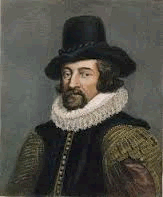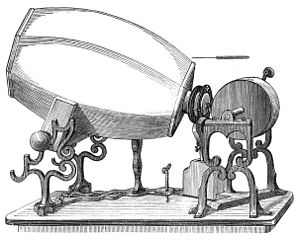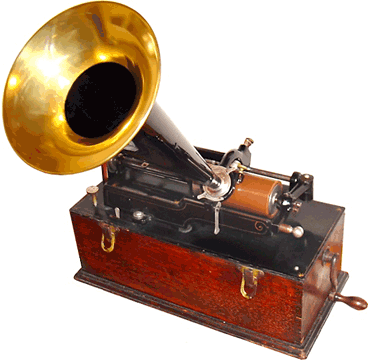
google images
Origins of Electronic Music I (9:53) Start 3:33
The New Sound Of Music Part1 (10:53)

google images
"We have also sound-houses, where we practise and demonstrate all sounds and their generation.
We have harmony which you have not, of quartersounds and lesser slides of sounds.
Divers instruments of music likewise to you unknown, some sweeter than any you have; with bells and rings that are dainty and sweet.
We represent small sounds as great and deep, likewise great sounds extenuate and sharp; we make divers tremblings and warblings of sounds, which in their original are entire.
We represent and imitate all articulate sounds and letters, and the voices and notes of beasts and birds.
We have certain helps which, set to the ear, do further the hearing greatly; we have also divers strange and artificial echoes, reflecting the voice many times, and, as it were, tossing it; and some that give back the voice louder than it came, some shriller and some deeper; yea, some rendering the voice, differing in the letters or articulate sound from that they receive.
We have all means to convey sounds in trunks and pipes, in strange lines and distances." http://oregonstate.edu/instruct/phl302/texts/bacon/atlantis.html
"The phonautograph is the earliest known device for recording sound. Previously, tracings had been obtained of the sound-producing vibratory motions of tuning forks and other objects by physical contact with them, but not of actual sound waves as they propagated through air or other media. Invented by Frenchman Édouard-Léon Scott de Martinville, it was patented on March 25, 1857. It transcribed sound waves as undulations or other deviations in a line traced on smoke-blackened paper or glass. Intended solely as a laboratory instrument for the study of acoustics, it could be used to visually study and measure the amplitude envelopes and waveforms of speech and other sounds, or to determine the frequency of a given musical pitch by comparison with a simultaneously recorded reference frequency.
Apparently, it did not occur to anyone before the 1870s that the recordings, called phonautograms or phonoautograms, contained enough information about the sound that they could, in theory, be used to recreate it. Because the phonautogram tracing was an insubstantial two-dimensional line, direct physical playback was impossible in any case.
Several phonautograms recorded before 1861 were successfully played as sound in 2008 by optically scanning them and using a computer to process the scans into digital audio files." http://en.wikipedia.org/wiki/Phonautograph


http://en.wikipedia.org/wiki/Phonautograph
Au clair de la lune
http://en.wikipedia.org/wiki/Édouard-Léon_Scott_de_Martinville
"Bell was engaged in training teachers in the art of instructing deaf mutes how to speak, and experimented with the Leon Scott phonautograph in recording the vibrations of speech.
The first successful bi-directional transmission of clear speech by Bell and Watson was made on March 10, 1876 when Bell spoke into the device, “Mr. Watson, come here, I want to see you.” and Watson answered.
Bell's telephone transmitter (microphone) consisted of a double electromagnet, in front of which a membrane, stretched on a ring, carried an oblong piece of soft iron cemented to its middle. A funnel-shaped mouthpiece directed the voice sounds upon the membrane, and as it vibrated, the soft iron “armature” induced corresponding currents in the coils of the electromagnet. These currents, after traversing the wire, passed through the receiver which consisted of an electromagnet in a tubular metal can having one end partially closed by a thin circular disc of soft iron. When the undulatory current passed through the coil of this electromagnet, the disc vibrated, thereby creating sound waves in the air.
Thomas Alva Edison took the next step in improving the telephone with his invention in 1878 of the carbon grain "transmitter" (microphone) that provided a strong voice signal on the transmitting circuit that made long-distance calls practical. Edison discovered that carbon grains, squeezed between two metal plates, had a variable electrical resistance that was related to the pressure. Thus, the grains could vary their resistance as the plates moved in response to sound waves, and reproduce sound with good fidelity, without the weak signals associated with electro-magnetic transmitters. The carbon microphone was further improved by Emile Berliner, Francis Blake, David E. Hughes, Henry Hunnings, and Anthony White. The carbon microphone remained standard in telephony until the 1980s, and is still being produced." http://en.wikipedia.org/wiki/Invention_of_the_telephone
"The phonograph record player... is a device introduced in 1877 that has had continued common use for reproducing (playing) sound recordings; although when first developed, the phonograph was used to both record and reproduce sounds. The recordings played on such a device generally consist of wavy lines that are either scratched, engraved, or grooved onto a rotating cylinder or disc. As the cylinder or disc rotates, a needle, or other similar object on the device, traces the wavy lines and vibrates to reproduce the recorded sound waves.

http://en.wikipedia.org/wiki/File:EdisonPhonograph.jpg
Edison Museum Wax Cylinder Recording Session (HD (start 2:14-3:00 start 7:20 - 8:00)
"Early recordings were made entirely acoustically, the sound being collected by a horn and piped to a diaphragm which vibrated the cutting stylus. Sensitivity and frequency range were poor, and frequency response was very irregular, giving acoustic recordings an instantly recognizable tonal quality. A singer practically had to put his face in the recording horn. Lower orchestral instruments such as cellos and double basses were often doubled (or replaced) by louder wind instruments, such as tubas. Standard violins in orchestral ensembles were commonly replaced by Stroh violins which became popular with recording studios." http://en.wikipedia.org/wiki/Gramophone_record
http://www.youtube.com/watch?v=OAEb-HHIcn0
History of Recording Pictures of typical recording sessions.
Telharmonium Documentary Part 1
Telharmonium Documentary Part 2
The Art of Noises.pdf (1913)
Russolo Score (1914)
Luigi Russolo Corale 1921 Classic Industrial Noise Experimental Music
The Futurist Intonarumori by Russolo - 1
The Futurist Intonarumori by Russolo - 2
Rachmaninoff plays Rachmaninoff Prelude in C# minor (1919)
"In 1922, 30 radio stations were in operation in the United States, and 100,000 consumer radios were sold. Just a year later, 556 stations were on the air and half-a-million receivers were sold." http://www.wired.com/science/discoveries/news/2008/09/dayintech_0929
The original orchestration called for 16 player pianos (or pianolas) in four parts, 2 regular pianos, 3 xylophones, at least 7 electric bells, 3 propellers, siren, 4 bass drums, and 1 tam-tam. As it turned out, there was no way to keep so many pianolas synchronized, so early performances combined the four parts into a single set of pianola rolls and augmented the two human-played pianos with 6 or more additional instruments.
George Antheil - Ballet Mecanique
George Antheil - Ballet Mécanique Roll 2
Ballet Mecanique at the National Gallery of Art (9:53)
"The advent of electrical recording made it possible to use microphones to capture the sound of the performance. The leading record labels switched to the electric microphone process in 1925, and most other record companies followed their lead by the end of the decade. Electrical recording increased the flexibility and sound quality. However, the performance was still cut directly to the recording medium, so if a mistake was made the recording was useless." http://en.wikipedia.org/wiki/History_of_sound_recording
Revised John Ellinger, January - September 2013